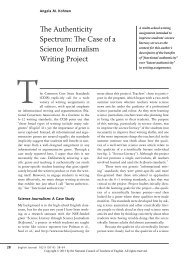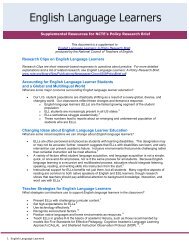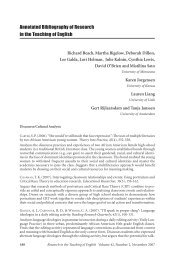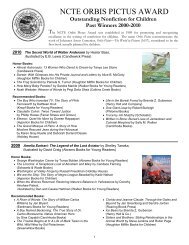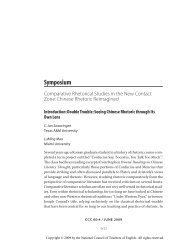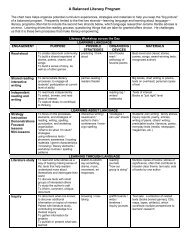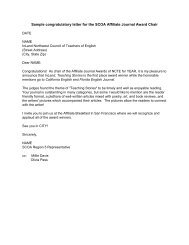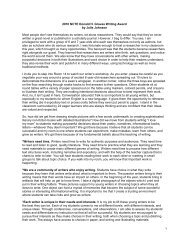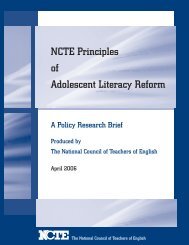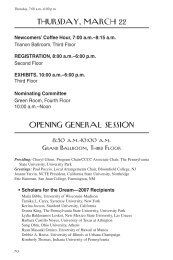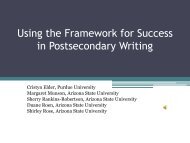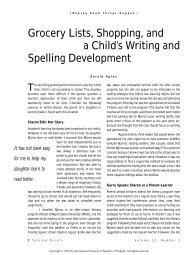Annotated Bibliography of Research in the Teaching of English
Annotated Bibliography of Research in the Teaching of English
Annotated Bibliography of Research in the Teaching of English
- No tags were found...
You also want an ePaper? Increase the reach of your titles
YUMPU automatically turns print PDFs into web optimized ePapers that Google loves.
224 <strong>Research</strong> <strong>in</strong> <strong>the</strong> Teach<strong>in</strong>g <strong>of</strong> <strong>English</strong> Volume 41 November 2006through <strong>the</strong> use <strong>of</strong> read<strong>in</strong>g logs. The studies looked at and classified 3,677 titles <strong>in</strong>to text types;narrative, <strong>in</strong>formational, mixed, and o<strong>the</strong>r. The first study documented <strong>the</strong> 1,487 books readaloud to preschool through 3rd grade students and noted 77% (1,132) <strong>of</strong> books were narrativescompared to 8% (120) <strong>in</strong>formational books and 1% mixed (20) texts. The second study followedk<strong>in</strong>dergartners to f<strong>in</strong>d that 77% (1,132) were narrative with 7% (110) <strong>in</strong>formational and3% (50) mixed. The f<strong>in</strong>d<strong>in</strong>gs <strong>in</strong> <strong>the</strong>se two studies confirmed that <strong>in</strong>formational texts are a smallproportion <strong>of</strong> read-alouds <strong>in</strong> early childhood classrooms, scarcity <strong>of</strong> <strong>in</strong>formational text readaloudsappear as early as preschool and cont<strong>in</strong>ues at least through 3rd grade, <strong>in</strong>formationalbooks ma<strong>in</strong>ta<strong>in</strong> <strong>the</strong>ir low status even when teachers read more than one book, young childrenhave very limited experience with <strong>in</strong>formational texts as read-alouds at home, and especially <strong>in</strong>Study 2 (at home with k<strong>in</strong>dergartners) <strong>the</strong>re is some evidence that boys may hear more <strong>in</strong>formationaltexts than girls. Br<strong>in</strong>gs to <strong>the</strong> critical front <strong>the</strong> consequences <strong>of</strong> limited experienceswith <strong>in</strong>formational text throughout and beyond <strong>the</strong> early childhood years as an area for ongo<strong>in</strong>gattention and research.O<strong>the</strong>r Related <strong>Research</strong>:ALLEN, K., & INGULSRUD, J. E. (2005). Read<strong>in</strong>g Manga: Patterns <strong>of</strong> personal literacies among adolescents.Language & Education, 19(4), 265-280.CAVAZOS-KOTTKE, S. (2006). Five readers brows<strong>in</strong>g: The read<strong>in</strong>g <strong>in</strong>terests <strong>of</strong> talented middle schoolboys. Gifted Child Quarterly, 50(2), 132-147.CROMLEY, J. G., & AZEVEDO, R. (2005). What do read<strong>in</strong>g tutors do? A naturalistic study <strong>of</strong> moreand less experienced tutors <strong>in</strong> read<strong>in</strong>g. Discourse Processes, 40(2), 83-113.CUNNINGHAM, J. W., SPADORCIA, S. A., ERICKSON, K. A., KOPPENHAVER, D. A., STURM, J. M., & YODER,D. E. (2005). Investigat<strong>in</strong>g <strong>the</strong> <strong>in</strong>structional supportiveness <strong>of</strong> leveled texts. Read<strong>in</strong>g <strong>Research</strong>Quarterly, 40(4), 410-425.DUNLOSKY, J., & RAWSON, K. A. (2005). Why does reread<strong>in</strong>g improve metacomprehension accuracy?Evaluat<strong>in</strong>g <strong>the</strong> levels-<strong>of</strong>-disruption hypo<strong>the</strong>sis for <strong>the</strong> reread<strong>in</strong>g effect. Discourse Processes,40(1), 37-55.FRANZAK, J. (2006). Zoom: A review <strong>of</strong> <strong>the</strong> literature on marg<strong>in</strong>alized adolescent readers: Literacy<strong>the</strong>ory and policy implications. Review <strong>of</strong> Educational <strong>Research</strong>, 76(2), 209-248.HAO, Z., & HOOSAIN, R. (2005). Activation <strong>of</strong> <strong>the</strong>mes dur<strong>in</strong>g narrative read<strong>in</strong>g. Discourse Processes,40(1), 57-82.HASBROUK, J., & TINDAL, G. A. (2006). Oral read<strong>in</strong>g fluency norms: A valuable assessment tool forread<strong>in</strong>g teachers. The Read<strong>in</strong>g Teacher, 59(7), 636-644.HIEBERT, E. H., & KAMIL, M. L. (EDS.). (2005). Teach<strong>in</strong>g and learn<strong>in</strong>g vocabulary: Br<strong>in</strong>g<strong>in</strong>g researchto practice. Mahwah, NJ: Erlbaum.KURBY, C. A., BRITT, M. A., & MAGLIANO, J. P. (2005). The role <strong>of</strong> top-down and bottom-up processes<strong>in</strong> between-text <strong>in</strong>tegration. Read<strong>in</strong>g Psychology, 26(4-5), 335-362.MANSELL, J., EVANS, M. A., & HAMILTON-HULAK, L. (2005). Developmental changes <strong>in</strong> parent’s use<strong>of</strong> miscue feedback dur<strong>in</strong>g shared book read<strong>in</strong>g. Read<strong>in</strong>g <strong>Research</strong> Quarterly, 40(3), 294-317.MANSET-WILLIAMSON, G., & NELSON, J. M. (2005). Balanced, strategic read<strong>in</strong>g <strong>in</strong>struction for upper-elementaryand middle school students with read<strong>in</strong>g disabilities: A comparative study <strong>of</strong>two approaches. Learn<strong>in</strong>g Disability Quarterly, 28(1), 59-74.MCINTYRE, E., PETROSKO, J., & JONES, D. (2005). Supplemental <strong>in</strong>struction <strong>in</strong> early read<strong>in</strong>g: Doesit matter for struggl<strong>in</strong>g readers? The Journal <strong>of</strong> Educational <strong>Research</strong>, 99(2), 99-107.NAGY, W., BERNINGER, V. W., & ABBOTT, R. D. (2006). Contributions <strong>of</strong> morphology beyond phonologyto literacy outcomes <strong>of</strong> upper elementary and middle-school students. Journal <strong>of</strong> EducationalPsychology, 98(1), 134-147.NEUMAN, S. B., & CELANO, D. (2006). The knowledge gap: Implications <strong>of</strong> level<strong>in</strong>g <strong>the</strong> play<strong>in</strong>gfield for low-<strong>in</strong>come and middle-<strong>in</strong>come children. Read<strong>in</strong>g <strong>Research</strong> Quarterly, 41(2), 176-201.



